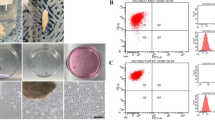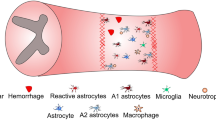Abstract
Multiple sclerosis (MS) is an immune-mediated demyelinating disease of the central nervous system (CNS). Cell transplantation may be an attractive therapeutic approach for MS which may promote remyelination and suppress the inflammatory process. Neural precursor cells are promising in transplantation strategies to treat an injury to the CNS, because of their ability to differentiate into neural cells. Here, we investigated the use of polylactic acid/chitosan (PLA/CS) scaffold as 3D system which increases neural cell differentiation. Nerve growth factor (NGF), basic fibroblast growth factor (bFGF), and conditioned media were employed to induce PC12 cells into neural-like cells (NLCs) on nanofibrous PLA/CS scaffold. Enhanced numbers of neural structures and staining of nestin, microtubule-associated protein (Map2), and class III β-tubulin (β3-tub) were observed with PC12-cell-seeded nanofibrous scaffolds when compared with control medium. The results revealed that PC12 cells attach, grow, and undergo differentiation on the nanofibrous PLA/CS scaffold. Additionally, our study illustrates that transplanted PC12-derived NLCs into the brain lateral ventricles of mice induced with experimental autoimmune encephalomyelitis (EAE), the animal model of MS, significantly reduced the clinical signs of EAE. Histological examination showed attenuation of the inflammatory process in transplanted animals, which was correlated with the reduction of both axonal damage and demyelination.







Similar content being viewed by others
References
Jadasz JJ, Aigner L, Rivera FJ, Kury P (2012) The remyelination Philosopher’s Stone: stem and progenitor cell therapies for multiple sclerosis. Cell Tissue Res 349(1):331–347. doi:10.1007/s00441-012-1331-x
Chari DM (2007) Remyelination in multiple sclerosis. Int Rev Neurobiol 79:589–620. doi:10.1016/S0074-7742(07)79026-8
Miron VE, Kuhlmann T, Antel JP (2011) Cells of the oligodendroglial lineage, myelination, and remyelination. Biochim Biophys Acta 1812(2):184–193. doi:10.1016/j.bbadis.2010.09.010
Pluchino S, Zanotti L, Deleidi M, Martino G (2005) Neural stem cells and their use as therapeutic tool in neurological disorders. Brain Res Brain Res Rev 48(2):211–219. doi:10.1016/j.brainresrev.2004.12.011
Pluchino S, Furlan R, Martino G (2004) Cell-basedremyelinating therapies in multiple sclerosis: evidence from experimental studies. Curr Opin Neurol 17(3):247–255
Park KH, Kim H, Na K (2009) Neuronal differentiation of PC12 cells cultured on growth factor-loaded nanoparticles coated on PLGA microspheres. J Microbiol Biotechnol 19(11):1490–1495
Nojehdehian H, Moztarzadeh F, Baharvand H, Nazarian H, Tahriri M (2009) Preparation and surface characterization of poly-L-lysine-coated PLGA microsphere scaffolds containing retinoic acid for nerve tissue engineering: in vitro study. Colloids Surf B: Biointerfaces 73(1):23–29. doi:10.1016/j.colsurfb.2009.04.029
Medina Benavente JJ, Mogami H, Sakurai T, Sawada K (2014) Evaluation of silicon nitride as a substrate for culture of PC12 cells: an interfacial model for functional studies in neurons. PLoS One 9(2):e90189. doi:10.1371/journal.pone.0090189
Negrini S, D’Alessandro R, Meldolesi J (2013) NGF signaling in PC12 cells: the cooperation of p75 (NTR) with TrkA is needed for the activation of both mTORC2 and the PI3K signalling cascade. Biol Open 2(8):855–866. doi:10.1242/bio.20135116
Hughes AL, Messineo-Jones D, Lad SP, Neet KE (2001) Distinction between differentiation, cell cycle, and apoptosis signals in PC12 cells by the nerve growth factor mutant delta9/13, which is selective for the p75 neurotrophin receptor. J Neurosci Res 63(1):10–19
Noureddini M, Verdi J, Mortazavi-Tabatabaei SA, Sharif S, Azimi A, Keyhanvar P, Shoae-Hassani A (2012) Human endometrial stem cell neurogenesis in response to NGF and bFGF. Cell Biol Int 36(10):961–966. doi:10.1042/CBI20110610
Maric D, Maric I, Chang YH, Barker JL (2003) Prospective cell sorting of embryonic rat neural stem cells and neuronal and glial progenitors reveals selective effects of basic fibroblast growth factor and epidermal growth factor on self-renewal and differentiation. J Neurosci Off J Soc Neurosci 23(1):240–251
Du J, Tan E, Kim HJ, Zhang A, Bhattacharya R, Yarema KJ (2014) Comparative evaluation of chitosan, cellulose acetate, and polyethersulfone nanofiber scaffolds for neural differentiation. Carbohydr Polym 99:483–490. doi:10.1016/j.carbpol.2013.08.050
Capkin M, Cakmak S, Kurt FO, Gumusderelioglu M, Sen BH, Turk BT, Deliloglu-Gurhan SI (2012) Random/aligned electrospun PCL/PCL-collagen nanofibrous membranes: comparison of neural differentiation of rat AdMSCs and BMSCs. Biomed Mater 7(4):045013. doi:10.1088/1748-6041/7/4/045013
Prabhakaran MP, Venugopal JR, Chyan TT, Hai LB, Chan CK, Lim AY, Ramakrishna S (2008) Electrospun biocomposite nanofibrous scaffolds for neural tissue engineering. Tissue Eng Part A 14(11):1787–1797. doi:10.1089/ten.tea.2007.0393
Ghasemi-Mobarakeh L, Prabhakaran MP, Morshed M, Nasr-Esfahani MH, Ramakrishna S (2008) Electrospun poly(epsilon-caprolactone)/gelatin nanofibrous scaffolds for nerve tissue engineering. Biomaterials 29(34):4532–4539. doi:10.1016/j.biomaterials.2008.08.007
Cao H, Liu T, Chew SY (2009) The application of nanofibrous scaffolds in neural tissue engineering. Adv Drug Deliv Rev 61(12):1055–1064. doi:10.1016/j.addr.2009.07.009
Soleimani M, Nadri S, Shabani I (2010) Neurogenic differentiation of human conjunctiva mesenchymal stem cells on a nanofibrous scaffold. Int J Dev Biol 54(8–9):1295–1300. doi:10.1387/ijdb.092999ms
Gao S, Zhao P, Lin C, Sun Y, Wang Y, Zhou Z, Yang D, Wang X, Xu H, Zhou F, Cao L, Zhou W, Ning K, Chen X, Xu J (2013) Differentiation of human-adipose derived stem cells into neuron-likecells which are compatible with photocurable three-dimensional scaffolds. Tissue Eng Part A. doi:10.1089/ten.TEA.2012.0773
Su WT, Shih YA, Ko CS (2013) Effect of chitosan conduit under a dynamic culture on the proliferation and neural differentiation of human exfoliated deciduous teeth stem cells. J Tissue Eng Regen Med. doi:10.1002/term.1783
Mony JT, Khorooshi R, Owens T (2014) MOG extracellular domain (p1-125) triggers elevated frequency of CXCR3+ CD4+ Th1 cells in the CNS of mice and induces greater incidence of severe EAE. Mult Scler. doi:10.1177/1352458514524086
Ellwardt E, Zipp F (2014) Molecular mechanisms linking neuroinflammation and neurodegeneration in MS. Exp Neurol. doi:10.1016/j.expneurol.2014.02.006
Villegas GM, Haustein AT, Villegas R (1995) Neuronal differentiation of PC12 and chick embryo ganglion cells induced by a sciatic nerve conditioned medium: characterization of the neurotrophic activity. Brain Res 685(1–2):77–90
Villegas R, Villegas GM, Nunez J, Hernandez M, Castillo C (2005) Neuron-like differentiation of PC12 cells treated with media conditioned by either sciatic nerves, optic nerves, or Schwann cells. Cell Mol Neurobiol 25(2):451–461
Kennea NL, Waddington SN, Chan J, O’Donoghue K, Yeung D, Taylor DL, Al-Allaf FA, Pirianov G, Themis M, Edwards AD, Fisk NM, Mehmet H (2009) Differentiation of human fetal mesenchymal stem cells into cells with an oligodendrocyte phenotype. Cell Cycle 8(7):1069–1079
Ardeshiry Lajimi A, Hagh MF, Saki N, Mortaz E, Soleimani M, Rahim F (2013)Feasibility of cell therapy in multiple sclerosis: a systematic review of 83 studies. Int J Hematol-OncolStem Cell Res 7(1):15–33
Mikaeili Agah E, Parivar K, Joghataei MT (2014) Therapeutic effect of transplanted human Wharton’s jelly stem cell-derived oligodendrocyte progenitor cells (hWJ-MSC-derived OPCs) in an animal model of multiple sclerosis. Mol Neurobiol 49(2):625–632. doi:10.1007/s12035-013-8543-2
Aharonowiz M, Einstein O, Fainstein N, Lassmann H, Reubinoff B, Ben-Hur T (2008) Neuroprotective effect of transplanted human embryonic stem cell-derived neural precursors in an animal model of multiple sclerosis. PLoS One 3(9):e3145. doi:10.1371/journal.pone.0003145
Einstein O, Friedman-Levi Y, Grigoriadis N, Ben-Hur T (2009) Transplanted neural precursors enhance host brain-derived myelin regeneration. J Neurosci Off J Soc Neurosci 29(50):15694–15702. doi:10.1523/JNEUROSCI.3364-09.2009
Li Y, Liu M, Yan Y, Yang ST (2014) Neural differentiation from pluripotent stem cells: the role of natural and synthetic extracellular matrix. World J Stem Cells 6(1):11–23. doi:10.4252/wjsc.v6.i1.11
Mei N, Chen G, Zhou P, Chen X, Shao ZZ, Pan LF, Wu CG (2005) Biocompatibility of poly(epsilon-caprolactone) scaffold modified by chitosan—the fibroblasts proliferation in vitro. J Biomater Appl 19(4):323–339. doi:10.1177/0885328205048630
Fang P, Gao Q, Liu WJ, Qi XX, Li GB, Zhang J, Li ZH, Sun JL, Sun JH, Gao YM (2010) Survival and differentiation of neuroepithelial stem cells on chitosan bicomponent fibers. Chin J Physiol 53(4):208–214
Acknowledgments
We thank Student’s Scientific Research Center, Tehran University of Medical Sciences for financial support and research assistant.
Conflict of Interest
The authors declare that they have no conflict of interest.
Author information
Authors and Affiliations
Corresponding author
Rights and permissions
About this article
Cite this article
Hoveizi, E., Tavakol, S. & Ebrahimi-Barough, S. Neuroprotective Effect of Transplanted Neural Precursors Embedded on PLA/CS Scaffold in an Animal Model of Multiple Sclerosis. Mol Neurobiol 51, 1334–1342 (2015). https://doi.org/10.1007/s12035-014-8812-8
Received:
Accepted:
Published:
Issue Date:
DOI: https://doi.org/10.1007/s12035-014-8812-8




